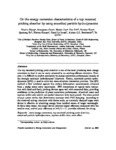On the energy conversion characteristics of a top-mounted pitching absorber by using smoothed particle hydrodynamics
| dc.contributor.author | Zheng, X | |
| dc.contributor.author | Chen, G | |
| dc.contributor.author | Cao, W | |
| dc.contributor.author | Xu, H | |
| dc.contributor.author | Zhao, R | |
| dc.contributor.author | Xu, Q | |
| dc.contributor.author | Kramer, M | |
| dc.contributor.author | Touzé, DL | |
| dc.contributor.author | Borthwick, Alistair | |
| dc.contributor.author | Li, Y | |
| dc.date.accessioned | 2021-11-09T19:03:43Z | |
| dc.date.available | 2021-11-09T19:03:43Z | |
| dc.date.issued | 2021-12 | |
| dc.identifier.issn | 0196-8904 | |
| dc.identifier.issn | 1879-2227 | |
| dc.identifier.other | 114893 | |
| dc.identifier.uri | http://hdl.handle.net/10026.1/18290 | |
| dc.description.abstract |
The top-mounted pitching point absorber is one of the most promising wave energy converters in that it can be easily attached to an existing offshore structure. However, it is difficult to predict accurately its energy conversion performance because of the strongly nonlinear hydrodynamic behaviour. Herein, smoothed particle hydrodynamics (SPH) is used to solve this wave-structure interaction problem. The SPH method is first validated against free surface deformation measurements obtained from a wedge water entry experiment. SPH simulations of regular wave interaction with fixed and freely pitching devices agree well with measured data, providing confidence in the prediction of power conversion performance. Absorbed power and capture width ratio exhibit uni-modal behaviour with wave period. The wave period of peak power within this distribution increases with PTO damping. According to the observed scaling behaviour with device scale, an optimally damped larger scale device is effective at absorbing energy from incident waves of longer wavelength. In finite deep water, the larger device achieves higher efficiency compared with the smaller ones, and its peak efficiency at 2πh/λ=1.1 provides reference for siting. | |
| dc.format.extent | 114893-114893 | |
| dc.language | en | |
| dc.language.iso | en | |
| dc.publisher | Elsevier BV | |
| dc.subject | Wave energy conversion | |
| dc.subject | Top-mounted pitching point absorber | |
| dc.subject | Smoothed particle hydrodynamics | |
| dc.subject | Capture width ratio | |
| dc.subject | Scale effect | |
| dc.title | On the energy conversion characteristics of a top-mounted pitching absorber by using smoothed particle hydrodynamics | |
| dc.type | journal-article | |
| dc.type | Journal Article | |
| plymouth.author-url | https://www.webofscience.com/api/gateway?GWVersion=2&SrcApp=PARTNER_APP&SrcAuth=LinksAMR&KeyUT=WOS:000712756700004&DestLinkType=FullRecord&DestApp=ALL_WOS&UsrCustomerID=11bb513d99f797142bcfeffcc58ea008 | |
| plymouth.volume | 250 | |
| plymouth.publication-status | Published | |
| plymouth.journal | Energy Conversion and Management | |
| dc.identifier.doi | 10.1016/j.enconman.2021.114893 | |
| plymouth.organisational-group | /Plymouth | |
| plymouth.organisational-group | /Plymouth/Faculty of Science and Engineering | |
| plymouth.organisational-group | /Plymouth/Faculty of Science and Engineering/School of Engineering, Computing and Mathematics | |
| plymouth.organisational-group | /Plymouth/Users by role | |
| plymouth.organisational-group | /Plymouth/Users by role/Academics | |
| dcterms.dateAccepted | 2021-10-16 | |
| dc.rights.embargodate | 2022-10-28 | |
| dc.identifier.eissn | 1879-2227 | |
| dc.rights.embargoperiod | Not known | |
| rioxxterms.versionofrecord | 10.1016/j.enconman.2021.114893 | |
| rioxxterms.licenseref.uri | http://www.rioxx.net/licenses/all-rights-reserved | |
| rioxxterms.licenseref.startdate | 2021-12 | |
| rioxxterms.type | Journal Article/Review |


